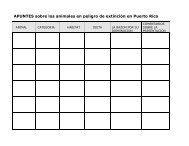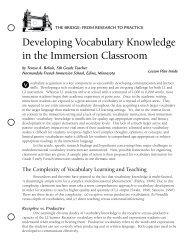The Six Prototypical Written Text Types (Genres) of Schooling
The Six Prototypical Written Text Types (Genres) of Schooling
The Six Prototypical Written Text Types (Genres) of Schooling
Create successful ePaper yourself
Turn your PDF publications into a flip-book with our unique Google optimized e-Paper software.
Fortune & Tedick – Oct 2003<br />
<strong>The</strong> <strong>Six</strong> <strong>Prototypical</strong> <strong>Written</strong> <strong>Text</strong> <strong>Types</strong> (<strong>Genres</strong>) <strong>of</strong> <strong>Schooling</strong><br />
Genre and Purpose Core Structural Features Key Linguistic Features<br />
Narrative (story)<br />
Ex. <strong>The</strong> Frog Prince<br />
(Science fiction, fantasy,<br />
fable, folk tale, myth, etc.)<br />
Orientation<br />
(tells who, where, when)<br />
Adverbs <strong>of</strong> Time (sometimes non-specific)<br />
e.g., one day, once upon a time, later, afterwards, in the end, etc.<br />
Purpose:<br />
To entertain, to tell an<br />
imaginary story, to teach<br />
Recount<br />
Ex. What I did during my<br />
summer vacation<br />
Purpose:<br />
To tell what happened, to<br />
reconstruct a chronologically<br />
ordered sequence <strong>of</strong> past<br />
events<br />
Instructions/Procedure<br />
Ex. How to ride a bike<br />
(Appliance Manuals,<br />
Medication Instructions,<br />
Sporting Rulebooks, Lesson<br />
Plans, etc.)<br />
Purpose:<br />
To tell how to do something,<br />
to provide a clear set <strong>of</strong><br />
directions for completing a<br />
specific task<br />
Series <strong>of</strong> Events<br />
(describes happenings preceding the<br />
complication)<br />
Complication<br />
(introduces main problem/conflict)<br />
Resolution<br />
(tells how problem gets resolved)<br />
Orientation<br />
(tells who, where, when)<br />
Series <strong>of</strong> Events<br />
Personal Commentary/Conclusion<br />
(states thoughts and feelings about the<br />
events, summarizes account)<br />
Heading/Title<br />
End Goal<br />
List <strong>of</strong> Materials/Ingredients<br />
Steps in Sequence<br />
Additional Suggestions<br />
Visual Aids<br />
Past Tense Action Verbs<br />
e.g., fought, chased, marched, jumped, slammed, etc.<br />
Person and Place Describing Words<br />
e.g., small, hidden, handsome, beautiful, mysterious, etc.<br />
Dialogue or “Saying” Verbs<br />
e.g., said, screamed, replied, insisted, remarked, etc.<br />
Adverbs <strong>of</strong> Time<br />
e.g., first, then, next, afterwards, at the end <strong>of</strong> the summer, etc.<br />
Past Tense Action Verbs<br />
e.g., drove, began, brought, carried, saw, etc.<br />
Person and Place Describing Words<br />
e.g., small, huge, interesting, new, rustic, fun-filled, etc.<br />
Action Verbs As Imperatives<br />
Cut, grasp, connect, secure, remove, align, etc.<br />
A Range <strong>of</strong> Adverbials<br />
Time (when): first, second, third, next, finally, lastly, etc.<br />
Manner (how): carefully, very slowly, finely, firmly with one hand, etc.<br />
Place (where): in a moderate oven, through the tunnel, onto the bread<br />
board, etc.<br />
Reason (why): to form a s<strong>of</strong>t batter, so that the filling does not come out,<br />
etc.
Genre and Purpose Core Structural Features Key Linguistic Features<br />
Classification<br />
Infrequent Use <strong>of</strong> Adverbs <strong>of</strong> Time<br />
(general statement <strong>of</strong> topic/<br />
phenomenon)<br />
Report<br />
Ex. Dolphins<br />
Purpose:<br />
To give information, to<br />
describe phenomena in a<br />
systematic manner<br />
Series <strong>of</strong> Description Paragraphs<br />
(Informational Characteristics: e.g.,<br />
habitat, appearance, food, behavior,<br />
predators, etc.)<br />
Relational (or linking) Verbs<br />
e.g., to be, to have (Frogs are amphibians. Frogs have webbed feet.)<br />
Technical Terms and Taxonomies<br />
Technical Terms: Tadpoles, transparent lenses, webbed feet, etc.<br />
Taxonomies: Orchestra à conductor, strings, woodwind, brass, percussion<br />
Often includes title and subheadings.<br />
Nominal Groups with Adjectives/Adjective Phrases<br />
e.g., Those young, fresh water tadpoles navigate with their long tails.<br />
Explanations<br />
Ex. <strong>The</strong> Water Cycle<br />
Purpose:<br />
To describe how something<br />
works, to give reasons for a<br />
phenomenon<br />
Phenomenon Identification<br />
(describes the phenomenon)<br />
Series <strong>of</strong> Events<br />
(<strong>of</strong>fers more detailed information<br />
about temporal or causal sequences)<br />
Purposeful Use <strong>of</strong> Personal Pronouns ( I, we, you, he, she, it, they)<br />
Inclusion (close reader-writer relationship): You can see that frogs have<br />
eyes that stick out so they can see well.<br />
Exclusion (distant reader-writer relationship):<br />
Frogs have protruding eyes, which allow for excellent vision.<br />
Nominalization (verb à noun)<br />
e.g., When we run, we can sprint, hurdle or we can run over longer<br />
distances. à Running involves either sprinting, hurdling or distance<br />
running.<br />
Relational (or linking) Verbs<br />
e.g., to be, to have (In the combustion <strong>of</strong> food, oxygen (O 2 ) is used and<br />
carbon dioxide (CO 2 ) is given <strong>of</strong>f.)<br />
Technical Terms and Taxonomies<br />
Technical Terms: Metabolism, thermal stress, digestion, oxygen<br />
consumption, basal metabolic rate, etc.<br />
Taxonomies: Human biological systems à circulatory, skeletal, digestive,<br />
muscular, etc.<br />
Nominal Groups with Adjectives/Adjective Phrases<br />
e.g., <strong>The</strong> ideal standard metabolic rate <strong>of</strong> an animal is established by<br />
determining its metabolism under the least physiologically demanding<br />
conditions.
Genre and Purpose Core Structural Features Key Linguistic Features<br />
Explanations (cont.) Phenomenon Identification<br />
Ex. <strong>The</strong> Water Cycle (describes the phenomenon)<br />
Purpose:<br />
To describe how something<br />
works, to give reasons for a<br />
phenomenon<br />
Discussion (one-sided)<br />
Argument (two-sided)<br />
Ex. Should smoking be made<br />
illegal<br />
Series <strong>of</strong> Events<br />
(<strong>of</strong>fers more detailed information<br />
about temporal or causal sequences)<br />
<strong>The</strong>sis/Personal Statement <strong>of</strong><br />
Position<br />
Supporting Arguments and<br />
Evidence<br />
Absence <strong>of</strong> Personal Pronouns<br />
(I, we, you, he, she, it, they)<br />
Exclusion (distant reader-writer relationship):<br />
Nominalization (verb à noun)<br />
e.g., When we run, we can sprint, hurdle or we can run over longer<br />
distances. à Running involves either sprinting, hurdling or distance<br />
running.<br />
Modals (to position a reader in a certain way)<br />
Certainty: must, will, should, etc.<br />
e.g., We must conserve our forests.<br />
Less Certainty: Might, may, could, etc.<br />
e.g., We might have solar powered cars in the future.<br />
Purpose:<br />
To evaluate an issue and<br />
persuade another, to take a<br />
position and justify it<br />
Refuting Counter-Arguments and<br />
Evidence<br />
Re-iteration <strong>of</strong> Point <strong>of</strong> View/<br />
Conclusion<br />
Nominalization (to create authority and de-personalize text)<br />
Connectives (as signposts for reader)<br />
Clarifying: to put it another way, in particular, to illustrate, etc.<br />
Showing Cause/Effect: is caused by, so that, etc.<br />
Indicating Time: initially, soon, until, before, etc.<br />
Sequencing Ideas: first, second, next, in summary, etc.<br />
Adding Information: additionally, furthermore, etc.<br />
Condition/Concession: if…the, even though, etc.<br />
Conjunctions (to link clauses within sentences)<br />
Clarifying: for instance, in other words, that is, namely, etc.<br />
Showing Cause/Effect: consequently, accordingly<br />
Indicating Time: meanwhile, previously, until then<br />
Sequencing Ideas: first, second, finally, in the first place, etc.<br />
Adding Information: and, most convincing, likewise, moreover,<br />
furthermore, etc.<br />
Condition/Concession: when…then, although, but, however,<br />
otherwise, nevertheless, despite this, etc.<br />
Sources:<br />
Gibbons, P. (2002). Scaffolding language scaffolding learning. Portsmouth, NH: Heinemann.<br />
Love, K., Pigdon, K., Baker, G., with J. Hamston. (2000). BUILT: Building understandings in literacy and teaching, 2 nd Edition. [CD-Rom]. Melbourne, Australia:<br />
University <strong>of</strong> Melbourne.
















